Part 1: Organic Dairy Advantages (Omega-3 EFA)
More Omega-3 Essential Fatty Acid
Marguerita B. Cattell, DVM, MS, Diplomate, ABVP-Dairy
Arden J. Nelson, DVM, Diplomate, ABVP-Dairy
What advantages does the production and consumption of certified organic food bring to the planet and its people? Principle advantage areas are water and soil conservation, less fossil fuel usage, less pesticide exposure, less antibiotic and hormone usage, and more CO2 sequestration by increased pasture areas. Organically produced foods also have different nutrient levels. These nutrient differences can have profound effects on our health as humans.
Organic is LESS. Organic production practices:
- Use less fossil fuel.
- Use fewer pesticides, antibiotics, hormones.
- Result in less run-off of nitrogen and water from land.
Organic is MORE. Organic foods have:
- More Omega-3.
- More CLA.
- More Vitamins A, D, E.
- More beta-carotene.
- More antioxidants.
We will present the importance of higher human intakes and show the organic differences in omega-3 EFA for this segment of the Organic Difference discussion. Part 2 will cover the needs for and the Organic advantage regarding conjugated linoleic acid (CLA) and vaccenic acid (VA).
Omega-3 Introduction
Humans need two poly-unsaturated essential fatty acids (EFAs). These are the omega-3 (n-3) and omega-6 (n-6) EFAs. Humans cannot synthesize these EFAs nor any acceptable substitutes. EFAs are fats. If we eat less fat, we eat less Omega-3 and Omega-6. If we eat no fat, we eat no EFAs. Consumption of the right ratio of omega-6 and omega-3 is very important for our health.(1,2)
Let us consider a list of modern human diseases (2).
- Heart Attack
- Stroke
- Cancer
- Obesity
- Insulin Resistance
- Diabetes
- Asthma
- Arthritis
- Lupus
- Depression
- Schizophrenia
- Attention Deficit Hyperactivity Disorder
- Postpartum Depression
- Alzheimer’s Disease
What is the common link in the above listed typical diseases that are affecting western civilized man today? ANSWER: omega-3 essential fatty acid deficiency (2).
How Did We Get Here?
It is believed that our evolving ancestors thrived on a diet that was around 1:1 to 2:1 ratio of omega-6 to omega-3. Today our typical American diet is estimated to be somewhere between 15:1 to 20:1!
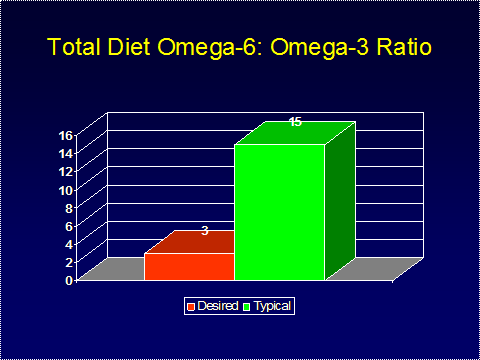
How did we get to the point of suffering from a plague of diseases that have a fairly simple EFA deficiency as one of the principle causes? It was a multi-step process that has taken thousands of years, but most of the high impact changes have happened since 1950.
First, we domesticated animals and grazed them on grass that was growing in the wild. (no problem, their diet had not really changed from the wild animal state). Then we discovered that if we fed them some grain (high in omega-6), that the meat taste different along with faster growth (this is the start of the problem). Then during 1950-1960, we discovered that animals raised totally in confinement on diets of almost entirely grain would grow and fatten at remarkably faster rates than grazed animals (much greater problem). Then, we humans started eating more grain (more omega-6) directly, as well as feeding large amounts of grain to chickens, pigs, and dairy and beef cows. Then we were taught that saturated fat and cholesterol intake was at least an exacerbating factor in creating heart disease, and we started to eat less animal fat in the form of eggs, meat and dairy products (this reduced our intake of omega-3 after we already decreased the omega 3 content of the animal fats we were eating). Then we started eating vegetable oils (corn, sunflower and safflower) as a result of the non-research based urgings of the vegetable oil industries (this increased our intake of omega-6 and decreased our intake of omega-3 even further). Simultaneously, the food processing industry learned that the earlier spoilage of omega-3 containing foodstuffs was a large detriment to mass distribution and use of animal fats was becoming taboo, so all of our processed foods contain next to no omega-3 and are based solely on cheap vegetable oils that are very high in omega-6 EFA (just read the potato chip bag).Then, due to obesity increasing, we developed our fear of fat in general, regardless of its supposed nutrient content , even nutrients that we absolutely have to eat to remain healthy (this reduced even further our intake of omega-3). Therefore we have low-fat and no-fat foods everywhere! Finally, due to increasing mercury contamination of fatty ocean fish, we have reduced our intake of our main source of omega-3 other than grazed animals and poultry.
So, we have managed to create a nutrient deficiency caused list of diseases by changing our diets away from omega-3 towards omega-6. Even though we need both of these EFAs, we need a LOT LESS omega-6 and a LOT MORE omega-3 than we are currently consuming.
The Pinnacle Study in Nutrition and Heart Disease
The Lyon Diet Heart Study (7) was conducted in Lyon, France. They selected 600 heart attack survivors to track the effects of two different diets, a control diet and an experimental diet. The experimental diet was a slightly modified Crete diet, being about 35% total fat, with an O6:O3 ratio of about 4:1. The control diet shall remain nameless until the end of this story, but it was similar in total fat and saturated fat, but much higher (15:1) in O6:O3 ratio. The outcomes measured would be the rate of subsequent heart attacks, and deaths from heart attacks.
The study was scheduled to last for 5 years. After four months passed, already there existed a statistically significant lower heart attack rate in the experimental diet participants. Never before had a diet intervention yielded such dramatic early results! After only 22 months of the study, it was stopped due to the inhumanity of continuing to feed the poor people the control diet any longer!
What reduction in heart attack rate would get your attention, and encourage you to change you diet now, and then tell everyone in the world about it?
When the study was stopped, there was a 60% reduction in heart attacks in those lucky participants on the experimental diet! And a 76% reduction in deaths due to heart attacks! Oh, lest I forget…What was the control diet? It was close to the American Heart Association’s recommended prudent heart diet that restricts the intake of saturated fats and cholesterol!
This study has been published four times in refereed medical journals, and yet we have not heard about it, our physicians basically are still recommending the same old song of less cholesterol in diets and blood as the only answer to preventing heart attacks, when in reality, cholesterol probably has very little to do with causation of heart attacks.(3) The Framingham, MA diet intervention study that is the foundation of the cholesterol-saturated fat theory of heart attack cause, only reduced heart attack rate by about 1.5% Which study would you be willing to risk your life on?
Have you heard about this research? Surely, if a study resulted in such dramatic differences in survival in a country where heart attack is still the number one killer and one out of every two Americans will suffer a heart attack, one would think we would be told about it, again and again!
Remember please, that heart attacks are only one of the 14 diseases that have been demonstrated through research to be at least linked to improper O6: O3 ratio.
How Do We Fix Our Nutrition Problem?
We simply need to eat more omega-3 and eat less omega-6 EFAs. Returning to the farming and animal production system in place prior to 1950 would return our animals to organic and grass fed! Animals that graze (anything green has more omega-3) and that eat less grain (higher in O6) produce products with lower O6:O3 ratios. Higher forage diets for dairy cows mean more O3 in the milk. Cows are what they eat, and we are too. Nutrition almost totally dictates the milk production level, the healthfulness, and reproductive performance in dairy cattle. Nutrition means everything to dairy cows, likewise with we humans! More greens (forage) means more omega-3 in cattle. More grains means more omega-6. This is true for humans, too. Do you choose greens or grains?
Eat More Omega-3 EFA
Eat more fatty ocean fish, more seafood, and take fish oil as a supplement every day. Green vegetables are high in Omega-3. Flax seed oil (linseed oil) is rich in linolenic acid, which most humans can convert to the active omega-3 we need. Cod liver oil is also a source of omega-3 with the added benefit of high doses of Vitamin A and D. Eat all animal proteins from grass fed animals. Grass fed animal and poultry fat is typically 3-5 times higher in omega-3 and much lower in omega-6 than a typical, conventional grain fed fat.
Eat Less Omega-6 EFA
Avoid ALL vegetable oils other than coconut oil, olive oil, and canola oil. If you cannot remember which ones to avoid, just read the potato chip bag ingredient list! Use olive oil in salad applications, coconut oil for cooking where the strong flavor is not a detriment, and canola oil for high heat cooking where less flavor is desired. Butter from grass-fed ruminants is great for cooking and is very high in omega-3 and very low in omega-6 compared to typical butter. Example of grass-fed butter O6:O3 ratio is 1:1!
Please remember to store all oils in the refrigerator. The higher omega-3 levels in recommended oils allow for easier and earlier rancidity due to oxidation.
In fact, organic and grass fed chickens, pigs, goats, sheep, dairy cattle, and beef cattle are one of THE ANSWERS to the nutrition problem we face today.
So, is organic meat and milk higher in omega-3 than omega-6? YES. Organic animal production requires animal access to pasture. Pastured animal products have lower O6:O3 ratios than non-pastured or confinement-only animal products. Typically, organic milk is higher in O-3 and lower in O-6 than conventional milk, and grass fed (no grain) is higher in O-3 and lower in O-6 than organic milk. Best of all possibilities for lowering O6:O3 ratio is organic and grass fed (no grain). Please see the graphs in the Appendix (Adapted from 2,6).
Research Results:
Ellis, United Kingdom
In a 12 month long study Ellis and colleagues studied the differences in 17 organic and 19 conventional milk herds in the United Kingdom. Organic milk had 17% higher(P4) Really good news for the health of organic dairy consumers!
Bergamoa, Italy
Bergomoa and colleagues studied the nutrients in organic and conventional milk by analyzing dairy products made from either buffalo or cow milk in Italy. Results for both animal source milks were essentially the same. They found that organic dairy products had much higher (41% higher) linolenic acid (omega-3) levels. Organic milk products also averaged 46% higher in alpha tocopherol (Vit E), and 60% higher in beta carotene (Vitamin precursor) than conventional milk products.
The researchers suggested that the ratio of CLA:linoleic acid could be a very predictable marker for distinguishing organic milk from conventional milk in Italy. Trans vaccenic acid (CLA precursor) was 105% higher in organic milk products. CLA level in organic milk was found to be 45% higher and linoleic acid (omega-6) was 192% lower than conventional milk. This produced the organic ratio of CLA:linoleic of .54 and the conventional ratio of .25. Organic milk was 116% higher than conventional milk in CLA:LA! (5)
Evidentaly factors in organic cows’ nutrition affect the conversion of linoleic fatty acid to conjugated linoleic acid in a very positive way. Isn’t it great! We need to eat more CLA, but we need to eat less LA! (Learn more about CLA in Part 2).
Please eat more omega-3 and less omega-6. Your body will thank you’re your health will reward you. Nutrition is everything to cows and to people, too!
APPENDIX: (Adapted from 2,6)
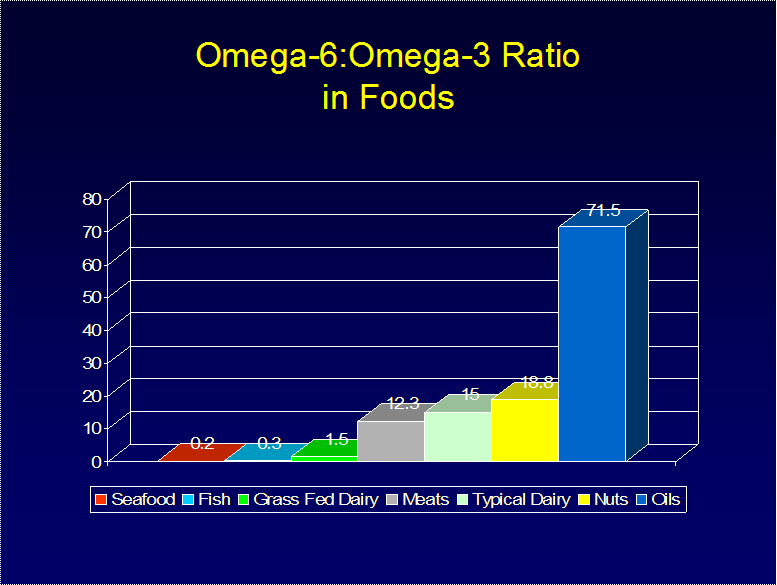
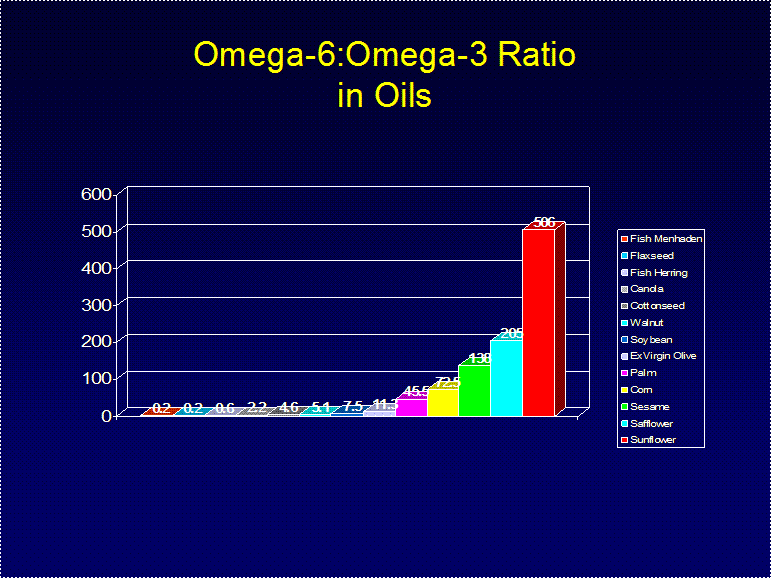
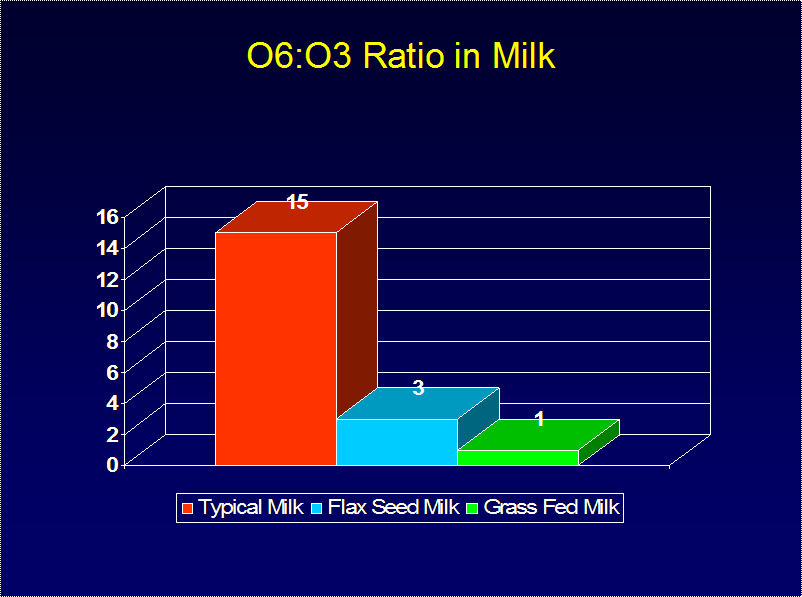
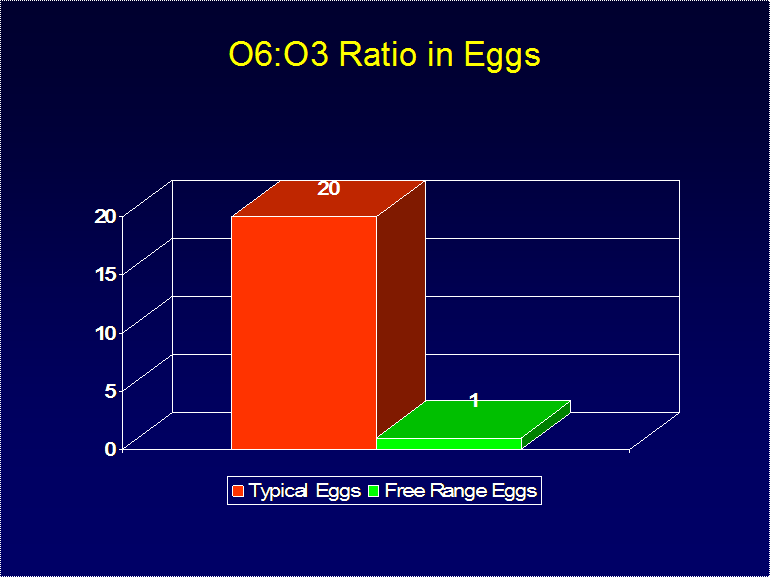
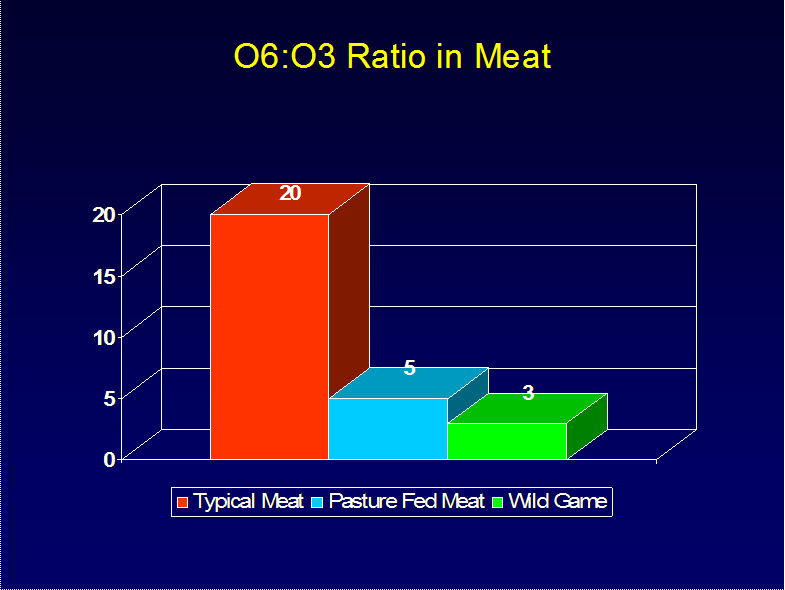
REFERENCES:
- The Queen of Fats. Susan Allport. 2006. University of California Press.
- The Omega Diet. Artemis Simopoulos, MD and Jo Robinson. 1999. HarperCollins Books.
- The Cholesterol Myths: Exposing the Fallacy that Saturated Fat and Cholesterol Cause Heart Disease. Uffa Ravnskov, MD. 2000. New Trends Publishing.
- Comparing the Fatty Acid Composition of Organic and Conventional Milk.
K. A. Ellis, 1 G. Innocent, D. Grove-White, P. Cripps, W. G. McLean,C. V. Howard, and M. Mihm. J. Dairy Sci. 2006. 89 :1938–1950. - Fat-soluble vitamin contents and fatty acid composition in organic and conventional Italian dairy products. Paolo Bergamoa, Elena Fedelea, Luigi Iannibellib, Giovanni Marzillob. Food Chemistry. 2003. 82:625–631.
- Know Your Fats: The complete Primer for Understanding the Nutrition of Fats, Oils, and Cholesterol. Mary Enig, PhD. 2000. Bethesda Press.
- The Lyon Diet Heart Study information was published FOUR times:
- The Lancet, 1994. Vol 343:1454-1458.
- American Journal of Clinical Nutrition, 1995. Vol 61(suppl):1360s-1367s.
- Journal of the American College of Cardiology, 1996. Vol 28(5):2203-2208.
- Circulation. 1999. Vol 99:779-785.